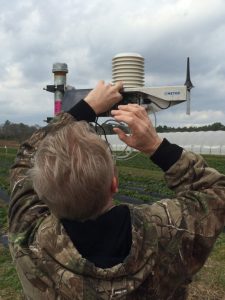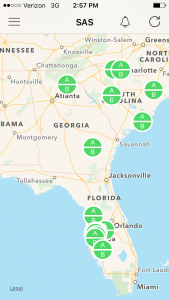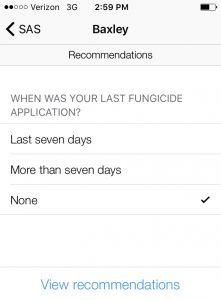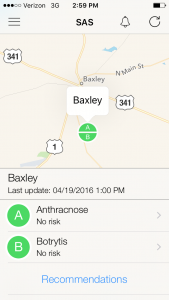We’ve been testing a new system developed by Natalia Peres, a UF/IFAS associate professor of plant pathology, to forecast when fungicides need to be applied. Currently, in Georgia we are experimenting with this in strawberries, but I hope this system or one similar can be used in many other crops in our area in the future. The system is called the Strawberry Advisory System (SAS). The technology is really impressive. You can visit the website at https://agroclimate.org/tools/strawberry/ .




An app can also be downloaded and alerts sent immediately to the farmers phone on when a field needs to be sprayed.

The phone app:

Below is an article written by Brad Buck, Science Writer for UF/IFAS Communication at the University of Florida explaining more about the Strawberry Advisory System:
GAINESVILLE — Farmers are adapting to a web-based monitoring system that can help the environment by using less chemical treatment to prevent strawberry diseases, which will help the state’s $306 million-a-year crop.
A new University of Florida Institute of Food and Agricultural Sciences study shows that the tool, known as the Strawberry Advisory System (SAS), uses data such as temperature and leaf wetness to tell growers when to spray fungicide to ward off diseases.
“Overall, the results show evidence of potential economic gains from switching from calendar to certain SAS-based options,” said post-doctoral researcher Theodoros Skevas, who led the study.
Most strawberry growers treat for fungi every week.
Natalia Peres, a UF/IFAS associate professor of plant pathology, helped develop the SAS in 2012 to give producers more precise times to chemically prevent two potentially deadly fungi. The SAS has two models, one to help farmers control Botrytis and the other to prevent anthracnose – two fungi that make the fruit rot.
For a new study published in the journal “Crop Protection,” UF/IFAS researchers examined the economic effects of traditional, calendar-based chemical treatments of strawberries and compared them to variations of the SAS, using different chemicals.
In order to compare the calendar-based system and the web tool, Skevas used production yields and costs, and historical strawberry prices (i.e. from 2000 to 2015) to construct simulated budgets. The historical strawberry prices helped to account for price volatility when measuring the economic performance of the calendar and SAS-based systems with different chemical treatments.
Researchers found that treatments following SAS recommendations with some products posed no greater risk than applying fungicides weekly. But the risk and economic performance depended on the choice of product used.
A UF/IFAS study published in 2014 showed the SAS can bring growers $1.7 million more in net profits over 10 years than a calendar-based fungicide system because it guides growers to spray their crop at optimal times.
Skevas said the latest study offers more precise product recommendations on which SAS-based systems growers would have better economic performance and reduced risks under different botrytis fruit rot conditions.
Peres and Zhengei Guan, an assistant professor of food and resource economics, supervised Skevas’ research. All three conduct research at the UF/IFAS Gulf Coast Research and Education Center in Balm, Florida.
Before SAS was developed, strawberry farmers traditionally sprayed weekly during the November-to-March growing season. Spraying more often than needed increases production costs and can lead to fungicide resistance, Peres said.
